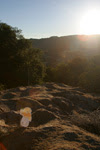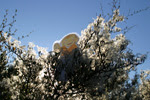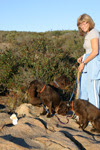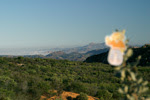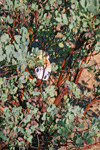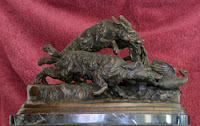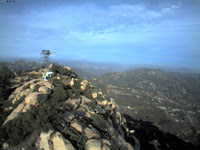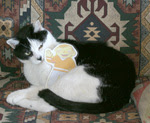
This is the second Flat Stanley Journal (see the first one here). Flat Stanley met some of our eight cats this morning. Here he’s snuggling with Tippy, the grumpy old man of our cats. About eight years ago, Debbie rescued Tippy from some terrible young hooligans who thought it was fun to hurt Tippy. She took him away from the bad kids, and we’ve given him a nice, safe home ever since. But he’s still grumpy. Tippy is the best jumper we’ve ever had (and we’ve had a lot of cats!). When he was younger, he could jump from the kitchen floor to the top of our refrigerator — and he made it look easy. Tippy got his name because of the tiny white tip on his tail (you can’t see it in this photo). Tippy’s favorite thing: he likes a little dish of half-and-half in the morning, when we make our coffee. He hollers at us if he doesn’t get it!
Maka Lea means “twinkling eyes” or “mischievous” in Hawai’ian, and that’s a really fitting name for him. He was sick (with a disease called distemper) when he was a tiny kitten, and as a result he’s very clumsy and awkward. But he doesn’t know it — he’s just a playful, happy cat. And it seems like he’s always getting into trouble — as Flat Stanley is discovering! Maka Lea’s favorite thing is to be taken outside and held in our arms right next to the hummingbird feeders. The hummingbirds aren’t scared of us at all — sometimes they’ll even land on our ears or our head. And even if we’re holding a cat (who would really like to eat a hummingbird or two), the “hummers” will buzz all around us, flying very close. Maka Lea loves it when the hummers hover right near by him!

Halala Pala means “big mellow” in Hawai’ian, and that name tells his story. We call him “the Ha” for short, because Halala Pala is quite a mouthful. He’s a great, big, roly-poly and very mellow kitty. We got him as part of a rescued feral cat litter, but we think he’s at least partly a kind of cat called “Maine coon” — known for their large size, mellow disposition, and markings just like Halala Pala has. Halala Pala’s favorite thing is a toy that looks like a small fishing pole with a feather where the hook would be. We swish that around, and you can see Halala Pala pretending that it’s a bird, and he’ll scamper all over the place trying to catch it.
Flat Stanley likes Halala Pala much better than Maka Lea!
By the way, when you see an apostrophe in the middle of a Hawai’ian word, that means you need to pronounce it with something called a “full glottal stop”. That sounds hard, but it’s really easy — it’s what you do when you say “oh-oh”. In Hawai’ian, you’d write that as “oh’oh”.

Well, after Flat Stanley heard about the hummingbirds from Maka Lea, he wanted to go out and see them for himself. So he climbed up on a hummingbird feeder and just waited for the hummers to show up. That took about 2 minutes — our hummers know they’re safe around our house, and that we have lots of tasty “hummer juice” for them to drink. Hummer juice is just a mixture of sugar and water, with a little food coloring in it to make it look pretty (the hummers really don’t care about that part). We have ten hummingbird and oriole feeders hung up outside our windows, each one holding between one quart and one and a half quarts — three gallons all together. The hummers will drain those completely empty in just over one day, in the summertime. It takes about 25 pounds of sugar to make a week’s worth of hummer juice in the summertime. In the winter, most of our hummers (all but one species) fly south to Costa Rica. In the springtime there are lots of flowers for them to drink the nectar from, so we don’t see them on our feeders so much. But from the summer until they leave around Halloween, they are chugging hummer juice at high speed. We figure we have between 300 and 400 hummers visiting us every day.
Flat Stanley made lots of hummer friends, and very quickly. In the picture above at far right, you can see one of the hummers coming in for a landing right by Flat Stanley’s feet. And in the other picture you can see quite a crowd of hummers. That particular kind of hummer feeder has eight places for hummers to drink from. We often see all eight places taken, with one or two hummers hovering just behind, waiting in line for their turn.

When you get really close to a hummingbird, it looks a little different than you might expect. In the far right picture (click to make it bigger) you see a male hummingbird, with his bright red throat patch. Right now the patch is a little tatty; they look their best in the springtime when they’re courting the females. Notice how those bright red features are splayed out above his “real” feathers — almost as if they were scales. And also notice how the normal feathers look almost stringy — each of those little “strings” is actually a teensy tiny little feather. If you touch a hummingbird, they’re not soft like you might expect — they actually feel a little stiff, sort of like a stiff paper bag. The left-hand photo shows a female hummer in the foreground, with that same male in the background. Notice how the female is much less colorful? This lets her hide better when she’s sitting on her nest, warming her eggs.
Flat Stanley really liked the hummers. I had trouble talking him into going for the rest of our walk. The first thing we stopped to look at was this patch of desert lillies. Like many lillies, these bloom in late summer or early autumn, instead of springtime. Botanists believe that this is a clever adaptation, so that the lily is in bloom when almost nothing else is — and all the bees and hummingbirds will visit it. In the springtime, the flowering plants are all competing with one another for the bee’s attention. The lillies don’t have this problem — they’ve got the bees all to themselves! We have lots of these lillies in our yard, and they grow all over the hill behind us. We look forward to them popping up every summer.

A short distance away, Flat Stanley found this big clump of Pampas Grass. This is not a native plant, but with a little water it grows very well here. This particular plant is about 8 feet across and 10 feet high. The beautiful white flowerheads come out in the late summer (these just erupted this week), bloom, and then turn into equally beautiful seedheads that stay good-looking for months. The whole time Flat Stanley was climbing up the Pampas Grass, we could hear him saying “ouch!", “ouch!” — because those pretty green grass blades have very sharp edges. In the closeup photo at left, in the part circled in blue you can see the tiny little “saw teeth” that line the edges of the Pampas Grass blades. They can give you a nasty cut. Who would expect that from grass? In the part circled in green, you’re looking at a very close-up view of Flat Stanley. See how the colors are actually made up of little tiny dots? Most color printers work this way. They usually only have three to six colors of ink in them — but they make up any other color by combining these little dots. For instance, lots of red dots with just a few yellow dots will look like a deep orange color — unless you have a magnifying glass powerful enough to see the individual dots, as in this picture.

Flat Stanley saw our tractor and wanted to go for a drive. We took him around the back part of our yard, and let him drive for a little while. We use this little tractor for all sorts of chores, saving us from digging or lifting by hand. We also use it to chip wood (we cut lots of brush every year), mow, and drill fence post holes. It’s a handy thing to have around! And lots of Flat Stanley fun, until he tried to drive into our fence! Along the way we passed by the tower that holds our weather station, and Flat Stanley couldn’t resist climbing it. This weather station measures the speed of the wind, what direction it’s coming from, the temperature, the humidity, the rainfall, and how bright the sun is. It has a radio transmitter in it that sends all the weather information to our computer, where we put it on a web site. Flat Stanley tried to climb all the way to the top, but he slipped and fell off. After he got up and dusted himself off, he said he was ready for a rest.
So we walked down to this big rock in our back yard. It’s an interesting place, because there are lots of things to see all in one place. You can see them all in the photo if you click on it to get a big version. The first thing to look at is the rock itself. It’s a very old rock; it’s been exposed to the air for hundreds of thousands of years. During that time, the wind, the rain, and plants (especially lichen) growing on the surface have all caused the rock to weaken, or “decompose”. The rock is granite — a kind of rock we usually think of as very hard and durable. But with enough time, even granite will break down. Decomposed granite forms all of our soil around here; it all comes from rocks like this one. Behind the rock is a large manzanita. Manzanitas like it best on the northern side of a hill, with very well-drained, sandy soil, near rocks, and on a small raised (elevated) place. That’s exactly where this manzanita is, and it’s a very happy manzanita because of that. On the right hand side of the picture, you can see a pine tree branch. That happens to be an Italian Stone Pine — not a native tree, but one that grows very well here. This particular kind of pine tree grows a “tap root” — a root that grows straight down into the ground until it finds water. Trees with a tap root can easily survive our long, hot, and extremely dry summertimes. Most pines do not have tap roots, so they cannot survive in our area unless you give them a lot of water in the summer. All of our water has to be pumped up from deep wells, most of which don’t have a lot of water in the first place — so it is expensive (for the pumping) and risky to have trees that need a lot of water. Down on the ground in front of Flat Stanley are some plants with very light green leaves forming a kind of umbrella over the bare dirt. These are just the right height for Flat Stanley to get some shade under. If you look very closely at the leaves of these plants, you’ll see they’re actually dark green, but covered with little tiny white hairs. This is a very common adaptation by desert plants, to protect them against drying out and overheating. These particular plants are very common on open ground in our area. To the left of Flat Stanley you can see a clump of scruffy-looking shrubbery poking out of the rocks. This is a monkey-flower shrub, and it’s one of our favorite plants in the area. Not because of how it looks now, of course — but because in the springtime these shrubs are completely covered in pale orange flowers. There something else surprising about this plant, too: it’s leaves are very sticky. Touching them feels a lot like touching the sticky part of a Post-It note. Flat Stanley got stuck in the monkey-flower, and we had to rescue him.
And after this adventure, Flat Stanley was plumb tuckered out. He’s taking a nap in his envelope again…















